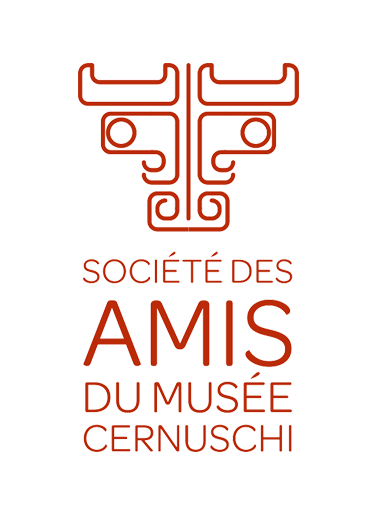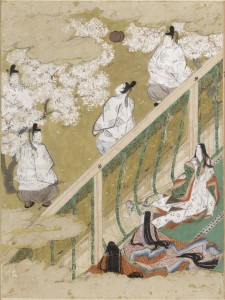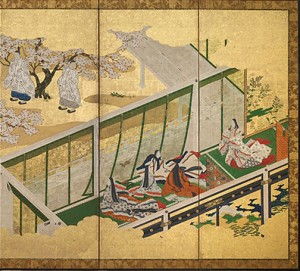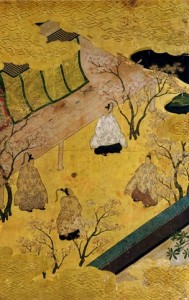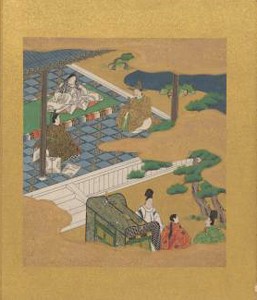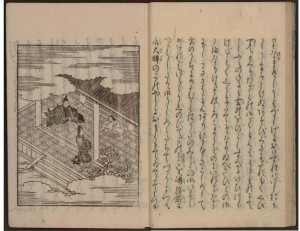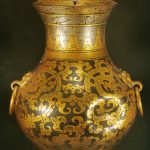Paintings related to the Tale of Genji in the seventeenth century
Wednesday 14 January 2015: conference Paintings related to the Tale of Genji in the seventeenth century by Estelle Leggeri-Bauer, Senior Lecturer at the National Institute of Oriental Languages and Civilizations (Inalco).
The Tale of Genji or Genji monogatari is a major literary work of 11th century Japanese literature attributed to Murasaki Shikibu. This court lady from the Heian period (794-1185) also left a newspaper and a collection of poems that earned her to be considered one of the great poets 36 of the time.
The Tale of Genji is an imposing work: it consists of 54 books which, translated into French, represents 2 pages. It seems that it was written like a serial novel and that the books came out over a ten year period. The readers were so impatient to know the rest that in a passage in his diary, the author tells that the regent burst into his apartments to seize the last chapter of his work. A first mention of the novel is already made dated 300.
From the beginning the Tale of Genji knew an extraordinary craze and this until the modern time, inspiring the painters, the calligraphers and today of the sleeves (Japanese comics) and movies.
The novel tells the life of a prince, Genji, from his birth to his death in the first part (chapters 1 to 41) and the love rivalry between two men, a grandson and a grand-nephew of Genji in the last part (chapters 42 to 54).
 |
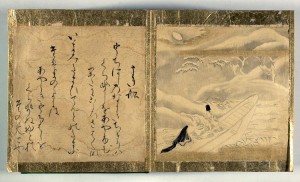 |
|
Murasaki Shibiku. |
Genji Monogatari. Ch.28. Tosa Mitsunori and Oinomikado Tsunetaka. Album of 54 chapters. |
Genji is the son of an emperor who separates him from the estate line and becomes a common man. He will however have a political career and the novel tells the rise of this man. The other theme of the novel are the love stories of this man of taste, extraordinary and bright. He has several wives, polygamy being common at the time Heian, but knows many adventures in love. The interest of this work is that it criticizes court life, its manners and intrigues with an inner look, almost intimate, by what is written by a lady of the court. The topics are very modern because there is the scorned woman, the jealous husband, the courtesan, the unrepentant seducer, the fascination of power, the different social classes and money.
The major difficulty of the novel lies in the number of characters (more than 200) whose names which are in fact titles (the use of proper names would have been considered vulgar and offensive) vary according to their social evolution over several tens of years. years.
Part of the craze for the novel is that it is addressed to readers who are part of the described world and that it is presented as a true story, without additions of wonderful. Another factor is the presence of poems incorporated into the text, either quotations of known poems, or creations of Murasaki Shikibu and the set was considered in the following centuries as a model for poetic composition.
The novel alludes to the history of Japan but also to that of China and shows the immense culture of its author, daughter of scholar and poet. She knew Chinese which was remarkable for a woman at the time. The first chapter deals with the exclusive and passionate love of the emperor for one of his wives who dies in giving birth to the future Genji and refers to the love of Tang Emperor Xuanzong for Yang Guifei. Another interest of the novel comes from the fact that there are treated painting, music and sartorial art, etc. and that he could thus serve as a guide for aristocratic society.
The book was written in the language used at the Heian court and was already unreadable a century later, which explains the many annotated and illustrated versions since the twelfth century as well as exegeses and commentaries. It has been read as well by men, including shoguns, as by women of the aristocracy.
Works that are hand-made copies with illustrations usually have one image per chapter, 54. The Tosa School, founded in the 15th century, particularly illustrated the Tale of Genji, with the works of Tosa Mitsunobu (1434-1525), (Tosa Mitsuyoshi (1539-1613), Tosa Mitsunori (1583-1638) or Tosa Mitsuoki (1617 -1691) and their workshops.
The scenes are represented in cavalier perspective (Fukinuki yatai = roofs removed), without the roofs, which allows to see the inside and the outside of the buildings. The use of golden clouds brings the softness of organic forms in opposition to the geometric shapes of the architecture and the format of the sheet. If the faces are sketched in the ancient tradition, the painters of the Tosa school have a taste for detail in the treatment of the clothes and various elements of the decoration (furniture, tatami mats, paintings in the painting, etc.). The worn costumes evoke those of the Heian period while the architecture and living environment are contemporary to the seventeenth century.
Often the text of these illustrated albums is reduced to a few lines of elegant calligraphy to sum up an entire chapter. For the prestigious works, the calligraphies were made by high dignitaries of the court and a copy presents the first two pages calligraphed by the emperor himself. In general, for collective works, one starts with the work of the person of highest rank, then one followed the protocol order until the middle of the work and one went up to finish by someone of immediately inferior to the one who wrote the first chapter. Calligraphy writers can be identified by their style and sometimes by annotations on the back of the pages. These collective works are a reflection of the society of the time. The texts are calligraphed on particularly luxurious sheets of paper, often decorated with silver or gold motifs.
Some screens or sliding doors could be adorned with album leaves. But the Tale of Genji also inspired painters to decorate screens, sliding doors or partitions. The effect, in this case, is more decorative and it is no longer the linear reading of an album but it is an evocation, an atmosphere that is perceived from afar. Often there are only a few scenes illustrated on the screens that are often the same, but some only receive one scene. The chapter 34 illustrated on a screen painted by Tosa Mitsuyoshi, shows the hero, Kashiwagi, throwing a furtive look at the Third Princess whose cat escaped on the gallery during a game of ball at the foot. This same theme is repeated on another screen by Tosa Mitsuoki, but the scene is seen from another angle and resumes the layout of a work by Tosa Mitsunobu. Often the screens come in pairs and the scene can sometimes develop on the twelve sheets as it can cover several sliding doors.
The choice of images can be based on pictorial tradition or literary tradition. As part of the visual tradition, painters rely on models and ink drawings that have been used as clichés for several centuries while adding their personal touch. As part of the literary tradition, the painter will illustrate the chapter by drawing inspiration from the calligraphy text. Generally it is a scholar who knows the novel well and who will coordinate the entire realization of the album. He chooses the texts to calligraphy and asks the painter to illustrate them.
At the beginning of the 17th century, things will change with the publication of printed works by xylography. It is from half of the century that one sees appearing the first printed works of Dit du Genji. In 1650, Harumasa Yamamoto (1610-1682), who was master lacquerer, decides to publish a version of the Tale of Genji in sixty volumes with his text version and 227 illustrations. Harumasa Yamamoto was close to literate circles but he wanted to make available to the public an understandable text accompanied by comments. The book was so successful that there were several reissues. The illustrations are often directly inspired by the pictorial tradition. The copy of the Library of Congress shows for the first chapter an illustration whose composition is close to a painting by Tosa Mitsuyoshi. This same scene painted by Tosa Mitsunori is often reused by other artists for printed works presenting only the 54 chapters or only extracts.
These printed books, however, did not prevent the production of very high-quality painted and calligraphic works in the form of horizontal scrolls for members of the court, but also more common productions for big bourgeois.
The Tale of Genji had many impressions until the nineteenth century with, sometimes, only a few illustrated chapters or chapters presented in the form of prints.
 |
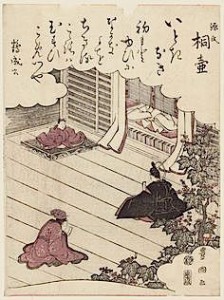 |
| Genji Monogatari. Sliding doors decorated with album leaves. | Genji Monogatari. Ch.1. Utagawa Toyokuni I (1769-1825). Printed album sheet |
